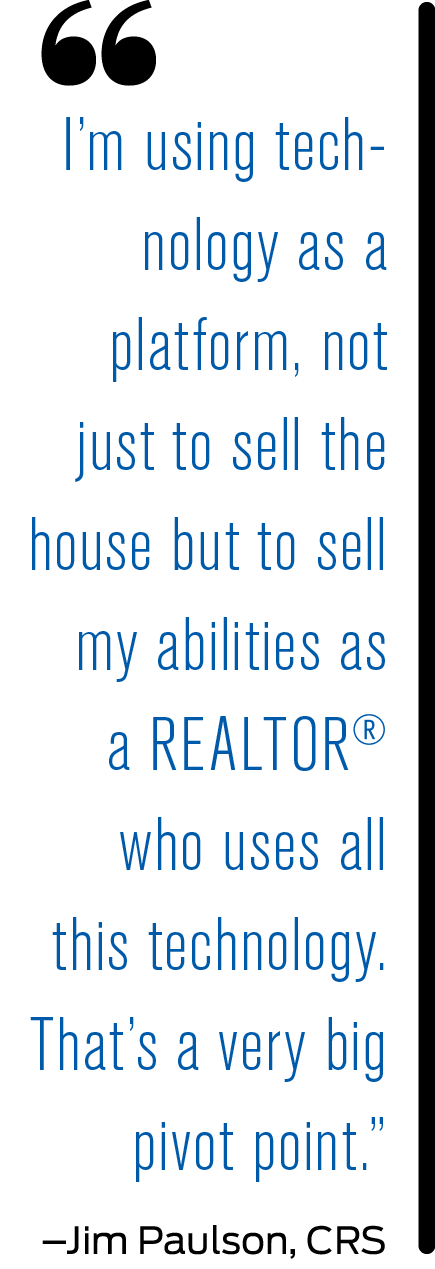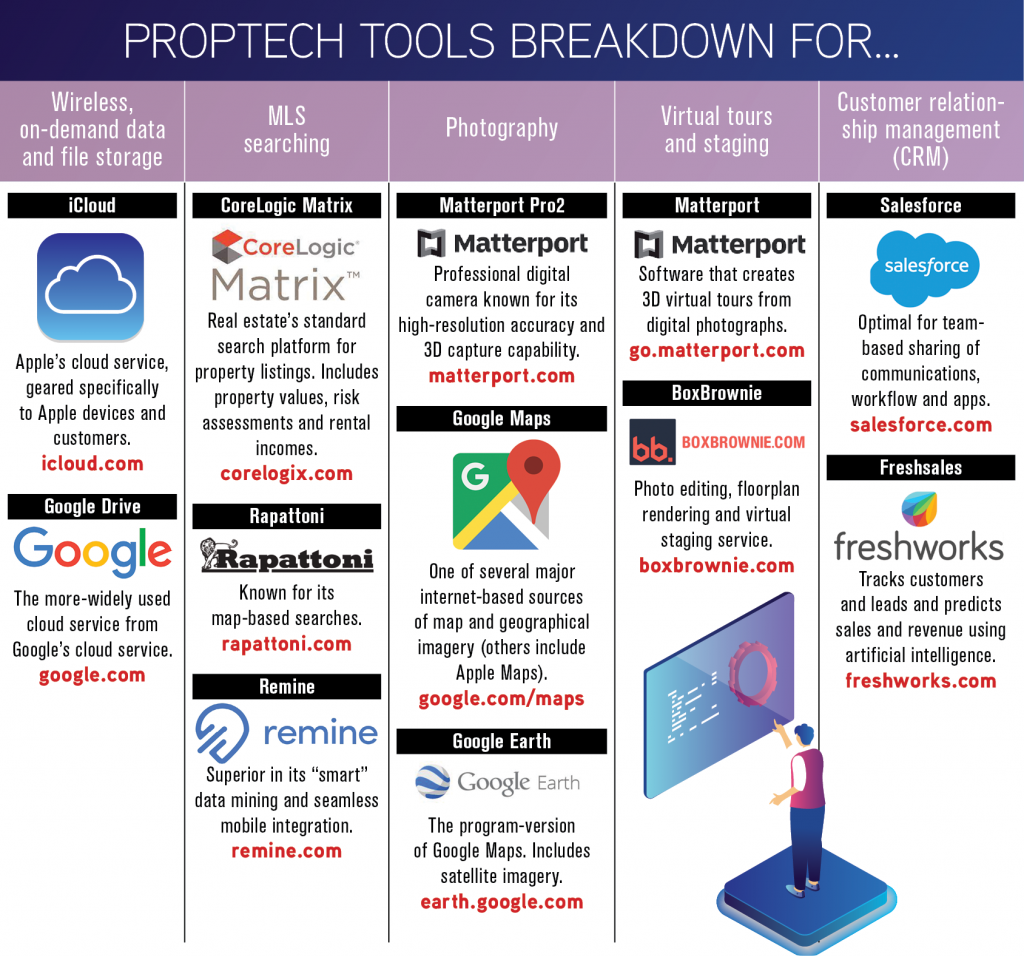Tech literacy is necessary for CRSs to stand out from the competition, and here are proptech options available for your business
By Shaila Wunderlich
It’s one of technology’s hottest categories, and each day more professionals are using it to leverage their real estate skill and experience.
But not everyone is using property technology, otherwise known as proptech, to its fullest. Some are hesitant about the time, effort and money required; others insist it isn’t necessary. “Real estate is always sort of late to the tech game,” says Jim Paulson, CRS, owner and broker at Progressive Realty Corporation in Boise, Idaho. “Unfortunately, we’re an industry based on ‘It’s always been that way.’”
Paulson and fellow real estate professional Liz Sturrock concede tech aptitude isn’t mandatory to working in real estate—but it sure helps. And they’re armed and waiting to assist any colleagues interested in getting started.
Master MLS
A firm mastery of the Multiple Listing Service (MLS) is ground zero to any tech-literacy effort. MLS’ savviest users employ its real-time search functionality on their websites. Others, meanwhile, are still applying it at its most rudimentary. “A REALTOR® could search the MLS every day for certain criteria, print out the results and deliver them to their clients,” says Liz Sturrock, chief of MLS and Innovation for Miami Association of REALTORS® (MAR). “Or they could build a ‘Save Search’ under each client’s name, and the system will automatically generate anything new that meets the criteria. Just doing the bare minimum like that gives you back time in your day and reduces error.”
About 85% of MAR’s 60,000 members use MLS in some capacity, assisted by Sturrock’s call- and messaging-center staff. She believes the success of any proptech lies in a custom approach, offering agents options for how they use it. “I never expect 100% adoption of anything,” she says. “Members take what works for them and leave the rest.”
Toward that end, MAR offers a choice of MLS platforms and ensures most of its trainers are bilingual. “CoreLogic’s Matrix is our primary MLS platform, but if they want something that has better mapping tools, we offer Rapattoni as an option,” Sturrock says. “Or they can do all their searches in Remine.”
Other essentials
MLS is a must, Paulson and Sturrock concur. The two real estate veterans also agree that there is a secondary group of proptech options that is equally essential. At the top of that list: the cloud. It’s a fundamental Paulson teaches in e-PRO®, NAR’s real estate technology certification course.
 “I used to store everything on my PC; now, I just keep all my contractual documents on the cloud and Google Drive,” he says. “As long as I have an internet connection, I have access to all my files.”
“I used to store everything on my PC; now, I just keep all my contractual documents on the cloud and Google Drive,” he says. “As long as I have an internet connection, I have access to all my files.”
Custom yard signs are another non-negotiable in Paulson’s opinion, with each sign featuring interior photos of the residence and a dedicated URL. This is where Paulson often gets pushback from hesitant REALTORS®, many of whom balk at the presumed time and expense entailed. “Once you have the system and template set up, time spent is nominal,” he says. “You don’t even have to do it yourself if you don’t want to. I have a virtual transactional coordinator that works off my Google Drive.”
Paulson photographs each of his listings himself using a Matterport camera, but he considers the option of farming out photography and website uploads equally feasible. Google Earth or Google Maps sub as free aerial-photo alternatives to more advanced and expensive drone photography. What Paulson appreciates most about these proptech options is the ability to up- or downscale them depending on the project and budget. “I don’t have to pay office or overhead fees, which makes my business 100% scalable.”
Sturrock thinks all REALTORS® should be using some sort of customer relationship management (CRM) tool, such as Salesforce or Freshsales. “Something that offers automated communication with customers to keep you in front of them,” she says.
“Then, I think social media is also so important,” she says. “Building your personal brand and getting it out there.” MAR’s division of REACH®, (NAR’s technology accelerator program), is currently working with a Miami-based company called Real Grader, which evaluates professionals’ social media presence across eight platforms and scores their profiles. “It’s like Credit Karma for real estate social profiles,” Sturrock says. “They tell you what you can do to enhance your profile, and for an extra fee will do it for you.”
The extras
From there, it’s about cherry-picking which proptech makes most sense for each individual and their work. “You could build a website with an artificial-intelligence chat engine,” Sturrock says. “It communicates with customers in real-time and allows the REALTOR® to enter the chat at any moment.
“You could use a tool like Remine, which surveys off-market listings and uses data science to assess how likely somebody is to buy a property,” she continues. “What if you could be the first person to identify and reach out to those customers—how powerful is that?”
Many see virtual property tours as “extra,” though Paulson begs to differ. “With the current market, I hear people saying the house is going to sell no matter what; no need for virtual tours,” he says. “What they don’t realize is it’s not just about selling the listing. It’s about getting more listings. And showing your capabilities as a REALTOR® is what’s going to accomplish that.”
The same Matterport camera Paulson uses for interior photos automatically creates virtual tours via its accompanying app. “I set up the camera on a tripod, and it rotates full-circle, taking around 75 pictures,” he says. “Then, the app stitches the images together into a virtual tour.”
Any real estate agents hiring house stagers would be remiss to ignore virtual alternatives like BoxBrownie. These online services edit and enhance photos, then use those photos to create floorplans and virtual interactive staging. “You can spend the $1,000-plus to hire a real stager and get scuffs on the walls, or you can pay around $20 per room to virtually stage it in a range of styles,” Paulson says.
Help is here
The beauty behind all proptech is that most of it comes with ample, affordable (sometimes-free) support. Paulson prefers going straight to the source for the most granular knowledge possible, but associations and brokerages excel in their real-estate specific approach. “We have three full-time trainers and four full-time outreach people who train on all our products and services,” Sturrock says. “But we’re happy to customize a class for a specific brokerage or have trainers from the individual companies come in, as well.”

Do you want to be a virtual agent? “NFTs and Real Estate,” taught by Kathleen Ryan, CRS, is available at CRS.com/recordings.
Photo: iStock.com/Macrostore








